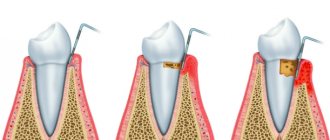53598
Crooked, unhealthy teeth can ruin the appearance of an otherwise attractive person. Oral health is important not only for our attractiveness, because the main function of teeth is to grind food. The condition of the stomach and intestines depends on this, which directly affects health and life expectancy .
Correct bite: what is it like?
Bite is the way the teeth of both jaws interact when they are completely closed. If it is correct, there are no difficulties when chewing and pronouncing sounds, the aesthetics of the smile is not impaired, but minor defects are still possible. What does a bite that does not require orthodontic treatment look like? Its main characteristics:
- Presence of 28–32 teeth. Not all people develop “eights”, which is determined by genetic factors. Their presence (if they have grown correctly) or absence does not affect the closure of the jaws. Moreover, in some cases, wisdom teeth removal is indicated during orthodontic treatment. Then there is more free space in the mouth.
- Symmetry in the closure of the dentition.
- The incisors of the upper jaw overlap the lower ones by one third.
- No interdental gaps, cracks or chips.
- Correspondence of molars and premolars of both dentitions to each other. Their closure is tight.
- Ease of chewing food, even hard ones. Opening the mouth is easy and there is no pain.
Correct bite does not always look aesthetically ideal. But the face is harmonious.
Bite after wisdom tooth removal
Some doctors are convinced that wisdom teeth are an atavism and must be gotten rid of. In ancient times, they were used to chew tough foods, such as raw meat. With the development of civilization, the human diet changed, his jaw began to gradually decrease - and the “eights” turned out to be superfluous. Most often, before starting to correct the bite, wisdom teeth are removed. This frees up space for the correct formation of rows, and the result of teeth alignment will be much better.
Types of correct bite
The above describes the orthognathic bite, which is the reference. It occurs in only 5% of people. But there are other types of teeth closure in which violations are not detected. What does each one look like? Experts identify the following bites:
- Biprognathic. Both jaws are slightly pushed forward, and the teeth are slightly directed towards the lips.
- Opisthognathic. The opposite of the previous type. The teeth are directed inward. Opisthognathic occlusion is rare. Its features are noticeable when viewed in profile.
- Progenic. The lower jaw protrudes slightly, but this feature is not pathological. The functioning of the temporomandibular joint (TMJ) and the functionality of the teeth are not impaired.
- Straight. The upper row of teeth is parallel to the lower one. The incisors touch their cutting edges. This feature is not a deviation, but it threatens rapid wear of the teeth due to increased load.
Sometimes, if you have one of these malocclusions, minor adjustments may be needed. But the treatment in this case will be easy.
Anomalies in the closure of teeth
Dental rows are not always placed correctly. How do you know when treatment is required? Depending on the type of malocclusion, the following signs of violations are distinguished:
- Distal - the upper jaw is more developed when compared to the lower jaw. She comes forward significantly.
- Mesial. The situation is the opposite of the previous case - the lower jaw is more developed. It may bulge forward slightly or strongly.
- Cross. With this pathology, there are interdental gaps. Part of the upper front teeth is behind the lower ones, and the other part is in front of them. Such a smile looks unaesthetic. As a rule, teeth grow in different directions.
- Deep – the upper row of teeth almost completely overlaps the lower one. If even more than 30% of the teeth are blocked, this is considered a pathology. But visually such a violation may not be visible.
- Open. When the jaws close, only the chewing teeth come into contact; pronounced gaps are visible between the front teeth. In some cases, it looks like an open mouth.
Whatever the diagnosis, any pathology must be treated.
How is the type of occlusion determined?
Only a specialist can accurately determine the bite and its type, but you can also find out on your own how close it is to ideal. There are certain standards:
- no interference with chewing or swallowing;
- occlusion does not impede breathing;
- there is no pain in the facial joints;
- when the mouth is closed, the dental elements do not damage each other;
- The teeth should be closed, not jostling, and not spaced apart.
These signs are valid when determining occlusion in both children and adults. It is also visually determined whether the face is symmetrical at rest. Does its median axis pass through the line of closure of the central incisors?
Important!
If you have problems pronouncing certain sounds or plaque constantly accumulates on certain teeth, then it makes sense to show your bite to the dentist. Using casts and x-rays, he will help you find out whether there are pathological changes in the structure of the jaws and their closure.
How to find out what kind of bite you have
Patients are often interested in how to determine whether their bite is correct. Usually the presence of abnormalities can be identified by facial features. It is also worth taking into account the criteria for correct bite described above. Go to the mirror, open your mouth and clench your teeth. In some cases, violations are immediately visible. Just because your smile looks aesthetically pleasing does not guarantee that everything is fine.
Even if you know what a correct bite should look like, it is impossible to make a correct diagnosis on your own. Only a specialist can do this. In addition to a visual examination and medical history, the doctor diagnoses the problem based on the results of a CT scan (computed tomography). Such an examination allows you to comprehensively assess the condition of the oral cavity. Disturbances in the placement of teeth are also identified by an impression made from an alginate mass. The orthodontist also needs photographs of the person’s face taken from several angles. Using them, you can evaluate the occlusal relationships of the dentition.
Why is it important that occlusion is correct?
Incorrect occlusion creates a lot of problems for a person.
- Chewing function is impaired. Poorly chewed food, entering the digestive tract, causes disturbances in all its departments.
- Damage and abrasion of dental elements and injury to the soft tissues of the oral cavity may also occur.
- In addition to organic problems, improper occlusion develops psychological disorders in a person. Typically, the jaw looks unattractive and disrupts the symmetry of the face. A smile looks ugly. Problems appear with the pronunciation of sounds. All this forms complexes and develops self-doubt.
A photo of a side view before and after correction of pathological bites clearly demonstrates how much a person’s face changes after correction.
Possible consequences of malocclusion
Anomalies in the location of the dentition relative to each other are fraught with the following problems:
- Increased stress on teeth, causing them to quickly wear out and break down. There is a risk of developing periodontal disease. If measures are not taken, a person may be left without teeth.
- Intensive formation of tartar. Sometimes bite pathologies do not allow you to properly brush your teeth.
- Increased gum sensitivity. Sometimes even ulcers form on them.
- Injury to the mucous membranes of the mouth, cheeks, gums, tongue, tissue inflammation.
- Development of TMJ diseases. They are provoked by increased load. These joints compensate for missing teeth. First, a person feels discomfort in the facial muscles, an unpleasant clicking in the TMJ, and pain appears. After some time, the headache begins to hurt, changes in appearance are visible.
- Malfunctions of the gastrointestinal tract. With malocclusion, it is difficult to chew food normally. Insufficiently crushed food ends up in the stomach, which leads to excessive stress on it. Over time, this can provoke some kind of disease.
- Disorders of respiratory, chewing and swallowing functions. If teeth are not positioned correctly, ENT diseases develop. Headaches and discomfort in the facial muscles appear.
In addition to problems with the health of the oral cavity and the body as a whole, malocclusion can provoke psychological problems. Because of an ugly smile, a person becomes insecure and complexes appear. Difficulties may arise with the pronunciation of sibilants.
Knowing how to determine whether your bite is correct, you can eliminate the problem in a timely manner before your health is damaged.
What it is?
Occlusion in dentistry is usually called the localization of the lower and upper rows of teeth relative to each other. It can be either correct or abnormal. It is worth noting that the formation of a correct bite occurs in infancy.
Active development begins during the period of breastfeeding and continues until the complete replacement of milk teeth.
During adolescence, people already have a formed bite, which will remain unchanged throughout the rest of their lives.
But, it can change under the influence of the following factors:
- one or more teeth have fallen out;
- there was an injury to the jaws or face;
- severe gum disease has developed, etc.
What causes malocclusion to form?
Defects appear for various reasons:
- Genetic predisposition. In most cases, mesial and distal bites are inherited. Therefore, parents who have this problem should take their child to an orthodontist in early childhood.
- Anomalies of fetal development. A child’s teeth are formed while still in the womb. During a complicated pregnancy or the influence of negative factors on its course, anomalies of the dental system can form.
- Birth injury. Mesial bite in some cases is a consequence of dislocation of the baby’s lower jaw during childbirth.
- Bad habits. Constant thumb or pacifier sucking, improper latching of the nipple, incorrect sucking during artificial feeding - all this provokes the development of malocclusion pathologies.
- Inferiority of the dentition. You can resort to removing baby teeth if there is less than a year left before the change. Otherwise, the dentition becomes asymmetrical, the midline shifts, and the chewing movements of the jaw are blocked. The formation of a permanent bite ends at approximately 15 years of age. For adults, after tooth loss, it is important to undergo prosthetics in a timely manner.
- Displacement of the jaws as a result of hypertonicity of the masticatory muscles, which can be observed due to stress.
Jaw injuries, as well as improper prosthetics, can provoke the development of malocclusions.
How to correct an overbite
Orthodontic treatment is carried out at different ages, but it is easier and faster in children. For adults, it takes longer to correct abnormal teeth alignment. The milk bite is also subject to correction. Although it will be replaced over time, permanent teeth grow in the place of their predecessors. Modern methods of bite correction are safe. They cause the patient only minor discomfort.
The doctor carefully studies the problem, assesses the condition of the oral cavity (if necessary, it is sanitized) and develops a treatment regimen. One of the following designs can be used in the process:
- Bracket systems. There are different types. They differ in aesthetic qualities, installation methods and prices. Such orthodontic structures will help correct almost any disorder.
- A mouthguard is a polymer product made from an individual impression. Easily removable, which is necessary for eating and brushing teeth.
- Records. The most effective designs for correcting primary malocclusion. They can also be given to adults, but this will not be the main treatment.
In complex cases (congenital pathologies), surgical intervention is required. Sometimes auxiliary techniques are used. Treatment of tooth wear in a “reducing bite,” in which dental tissue wears down with age, is carried out through prosthetics with crowns or veneers.
Remember! Correcting your bite is not only about getting a beautiful smile, but also a significant contribution to your health. Entrust the solution to your problem to a specialist. He knows how to check the bite for abnormalities. If they are identified, the correction will be carried out competently.
In an adult
Due to the fact that the correct structure of the jaws begins to form during the process of intrauterine development, it is the expectant mothers who directly depend on what the bite of their children will be.
If, starting from infancy, parents do not pay due attention to their children’s teeth, then as they grow up, they will face many problems.











